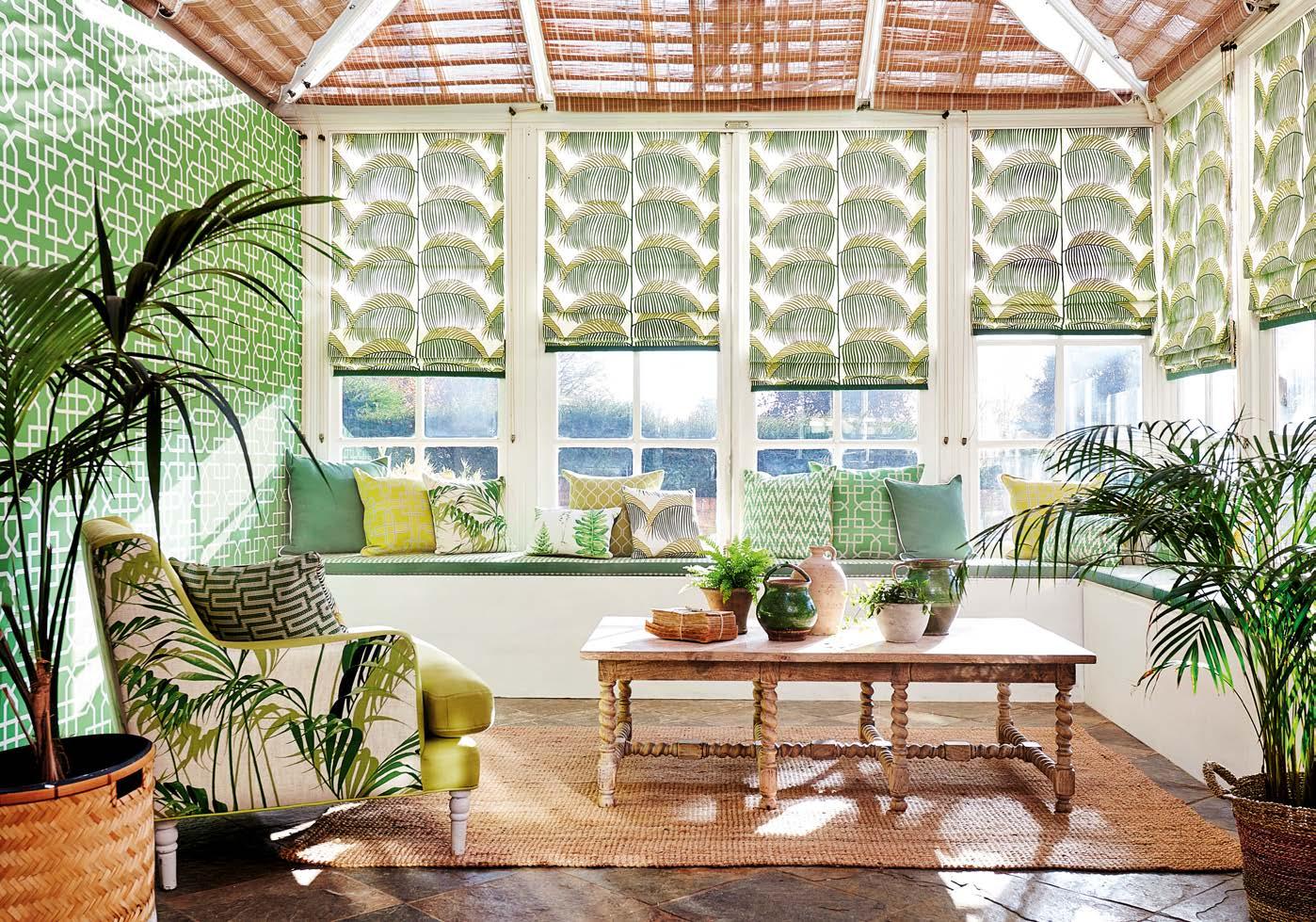
14 minute read
NATURAL CONNECTION Decorating ideas for orangeries and conservatories
Natural CONNECTION
Decorate a garden room, whether a conservatory, orangery or even a greenhouse, to provide an enjoyable space that bridges interior and exterior
Agarden room provides a natural link between a home and the green space beyond. It could be a conservatory in which to relax, an orangery designed for everyday living, or a greenhouse that doubles as a dining room in summer. Glazed structures like these create an extension to the home, a half-way space where house and garden, inside and outside, come together. Whether used year-round or only during warmer months, garden rooms can provide a sanctuary to retreat to, a practical well-lit place to read or paint in, or a space in which to socialise. However they are to be used, they can offer the perfect canvas on which to experiment with a more adventurous approach to interior design, introducing bolder patterns or furniture styles than elsewhere in the home. Often, the best sources of inspiration are the verdant plants and colourful blooms in the world outside. Being influenced by them can result in a pleasing synergy between interior and exterior zones.
ABOVE Blinds in Manilla emboridery, £69 a metre, all other fabrics and wallpaper all Glass House collection, Sanderson
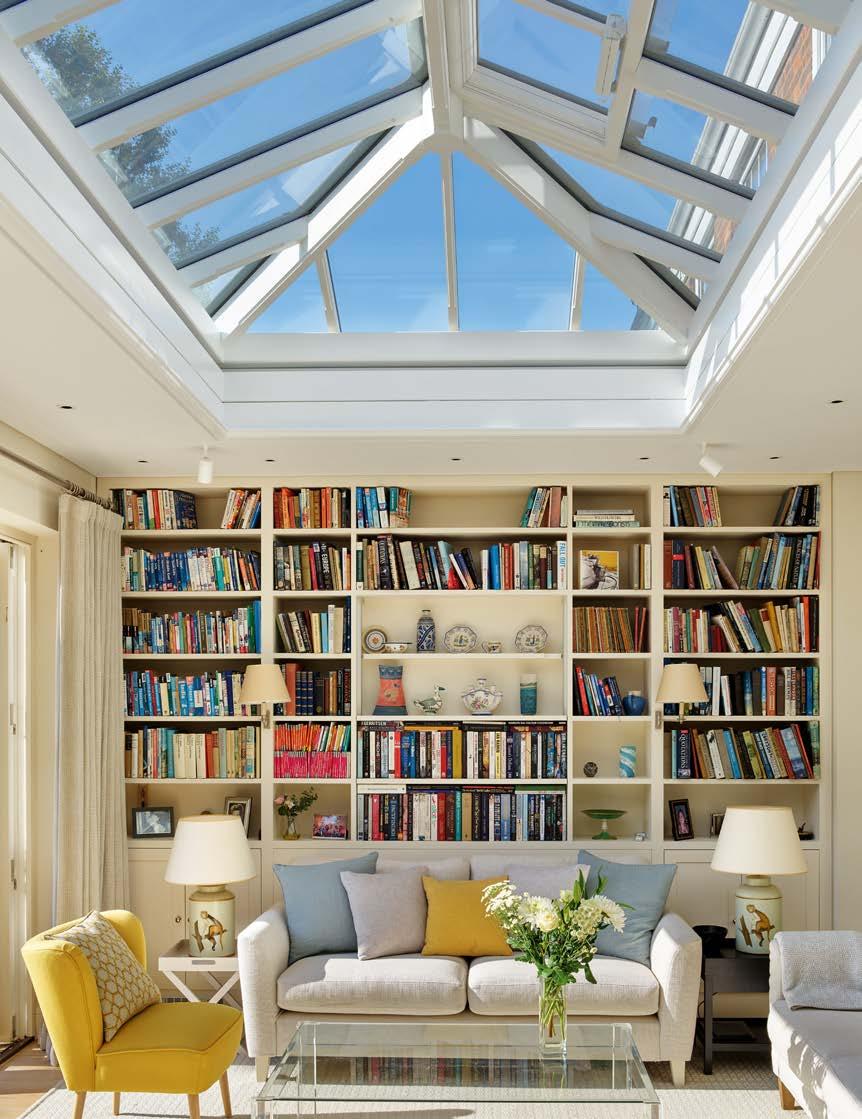
Style Notes
• Consider how the space will be used, year-round • Create a connection between inside and outside, as well as with exisiting interiors for flow
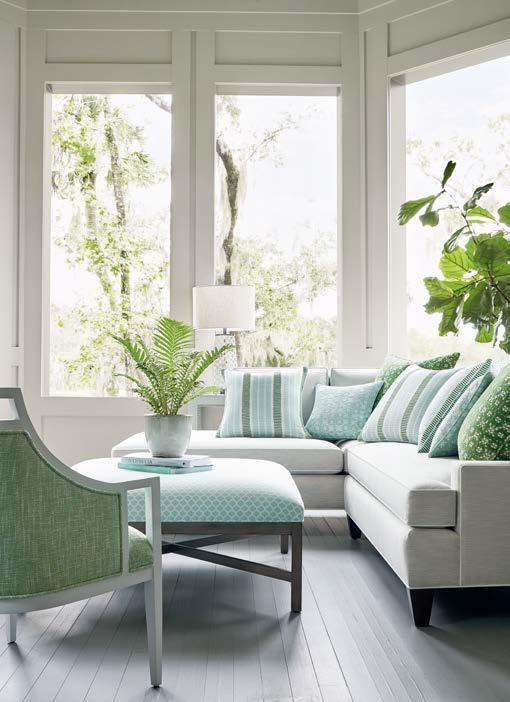
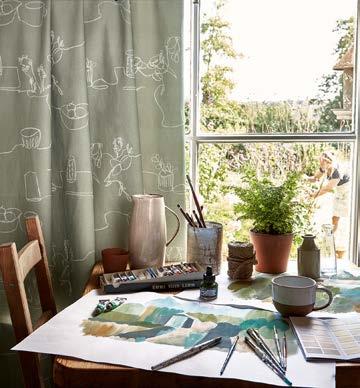
TOP An orangery from Vale Garden Houses provides an extra sitting room. ABOVE A garden room provides the perfect space for enjoying a hobby. Curtain, Tabletop Lichen, £31.50 a metre, Villa Nova
A MATTER OF CHOICE
Many properties already have a garden room or conservatory, but, for those thinking about adding one, there many different options to consider.
A classic conservatory with glazed walls, either floor to ceiling or half bricked, perhaps with a glazed or partially glazed roof as well, can be built in keeping with a particular period style. “It is important the design of a conservatory is sympathetic to the existing property in terms of both its size and its architectural detailing,” says Lisa Morton, director of Vale Garden Houses. “Mixing architectural periods would be frowned upon, unless the period of the property is less clearly defined, with additions or alterations made over the years, and it can take a more relaxed approach.” For a more contemporary aesthetic, clean-lined unfussy extensions with glazed walls are a popular option, perhaps including bi-fold doors and a roof lantern.
Greenhouses, too, can double-up as living spaces in the warmer months. “In recent years customers have shown a preference for lean-to and abutting structures so they can walk in seamlessly from their living space,” says Tom Barry, managing director of Hartley Botanic. “We see customers using their greenhouses for relaxation, dining and exercise. The environment of a greenhouse is extremely calming, allowing you to both fully take in your garden and be surrounded by the plants you are growing.”
John Lawson, sales director of Alitex, has also observed this shift, but cautions that single-glazed greenhouses are designed with

plants in mind and will be too cool for comfort through the winter months.
Stylist and author Selina Lake is full of enthusiasm, though. “There is something a little magical to me about spending time in greenhouses,” she says. “Due to their very purpose, they are warm spaces to hang out in, and being surrounded by plants makes them an ideal structure to just be in. A perfect example of how a practical space can still be appealing and inspiring.”
For those seeking a year-round living space, particularly for dining or a home office, a conservatory with heating for winter and ventilation for summer is usually the best solution. Something else to consider is a true ‘garden room’ – a structure built apart from the main house: the ideal place for teenagers or grown-up children, a home office, or gym.
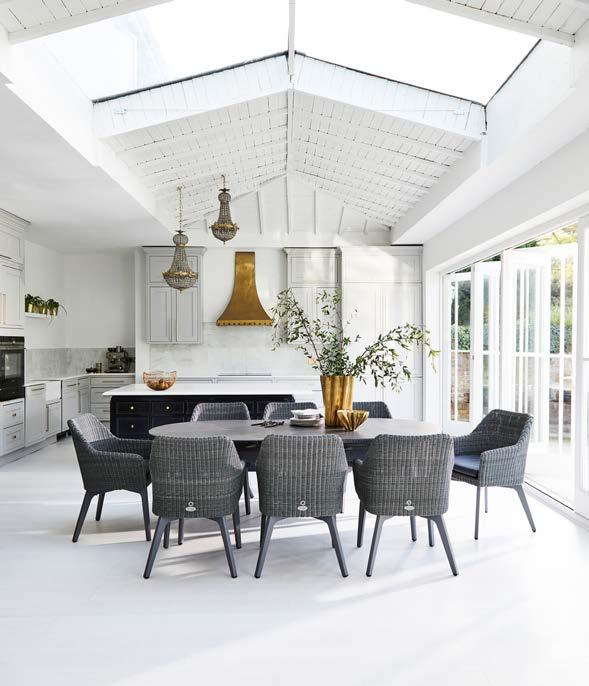
ABOVE LEFT Indooroutdoor fabrics are stylish and practical for a garden room. Selection from Landmark Textures collection, Thibaut ABOVE This citrusinspired wallpaper design is perfect for an orangery. Wallpaper, Orange Blossom, £115 a roll, Cole & Son RIGHT A part-glazed roof and bifold doors offer abundant light. Henley Ceramic Slate and Aluminium dining table with eight Cliveden dining armchairs, £6,699, Bridgman
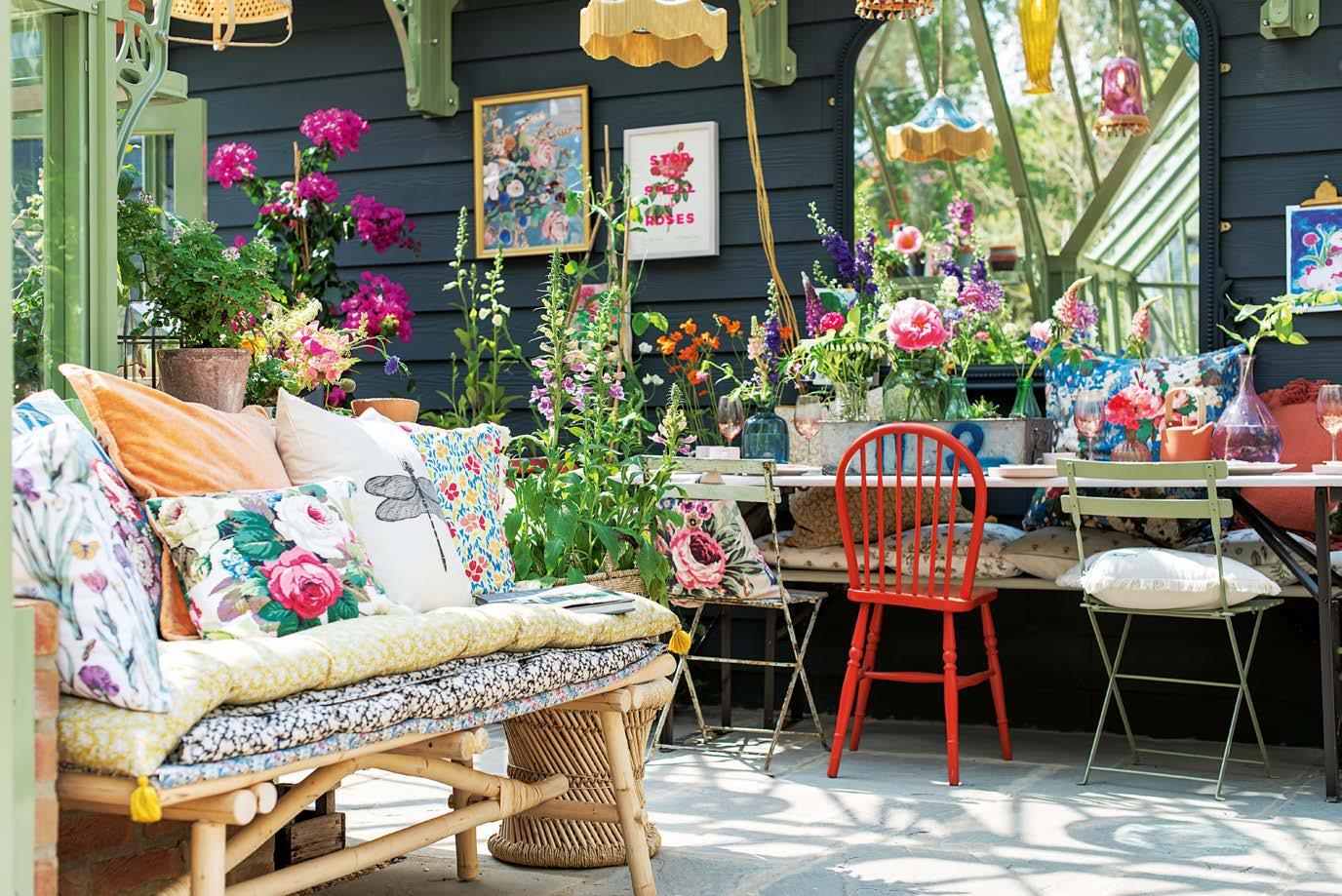

ABOVE Stylist Selina Lake has decorated this Alitex greenhouse with an abundance of o ers, echoed in oral cushions Mismatched chairs and lighting from Rothschild & Bickers make it a wonderful setting for dining LEFT ere, insects and plants are Lake’s inspiration for a home office or hobby space within a traditional glasshouse from lite
BRING THE OUTDOORS IN
Once a structure is chosen and its purpose defined, the pleasure of decorating and furnishing can begin.
“When designing a garden room, it is important to consider the viewpoints and incorporate colour schemes which work well with the outdoors,” advises interior designer Emma Sims-Hilditch. “Greens, blues, sunny yellows and neutral tones are all timeless choices which will complement the garden space.”
If there are walls that can be papered, a botanical motif that ties in with the external surroundings can work well. From small-scale florals or leafy patterns to grander mural-like papers, there is a plethora of designs to pick from. This can be an opportunity for a little fun, perhaps evoking a tropical mood with rainforest creepers, palm fronds and exotic blooms, with luscious greens and flashes of bright colour. Some papers evoke a Mediterranean feel or a classic ‘hot house’ look, recreating the aesthetic of a greenhouse within an orangery or conservatory.
Style Notes
• Take inspiration from nature to blur the boundaries between interior and exterior • Use botanical or floral designs, native or exotic, on walls and fabrics • Seek natural textures such as grasscloth to echo the garden • Accessorise with plants and flowers
RIGHT Tiles are a practical choice in greenhouses or conservatories, adding colour and pattern too. Turquoise Dreams encaustic cement tile, £160.80 a square metre, Otto Tiles BELOW A ‘hot house’ look has been created with a large-scale design used as a screen in a large glass house. Palm House, £245 a roll, and fabrics, Osborne & Little

In a greenhouse, plants provide the natural decor perhaps enhanced with playful soft furnishings. Selina Lake worked with Alitex to create a range of lifestyle settings within greenhouses. “Use cushions chosen to complement their surroundings and add floral pattern,” Lake suggests. “For a study area, let bees and other insects inspire a new greenhouse office scheme.”
Use vintage entomology prints on available walls, mixed with rustic secondhand furniture and metalwork painted green, then add lots of lush green plants, including succulents planted, for example, in a set of mini desk drawers. If window frames can be painted, consider soft green shades for a more seamless blend with the outdoors, or a soft neutral stone colour. It is important, also, to consider how a garden room connects to the rest of the house. Though a conservatory can feel like a separate area, if it flows from another room either in an open-plan manner or through glass, consider how the two zones can be integrated more cohesively. Interior designer Katharine Pooley suggests “using the same colour palette to really connect the space with the rest of the house, while also incorporating a variety of patterns and textures to add a layer of interest to the room.” Textured papers such as grasscloth can make a lovely choice for a neutral but interesting wall treatment with a tactile connection to the natural world.

RIGHT Create a backdrop full of colour with a mural featuring largescale blooms and an outdoor scene. Nirvana mural wallpaper, from £295, Woodchip & Magnolia BELOW RIGHT cho nati e ora and fauna with a woodland design. Woodland wallpaper in Lichen, £69 a roll, Fiona Howard


TYPES OF GARDEN ROOMS
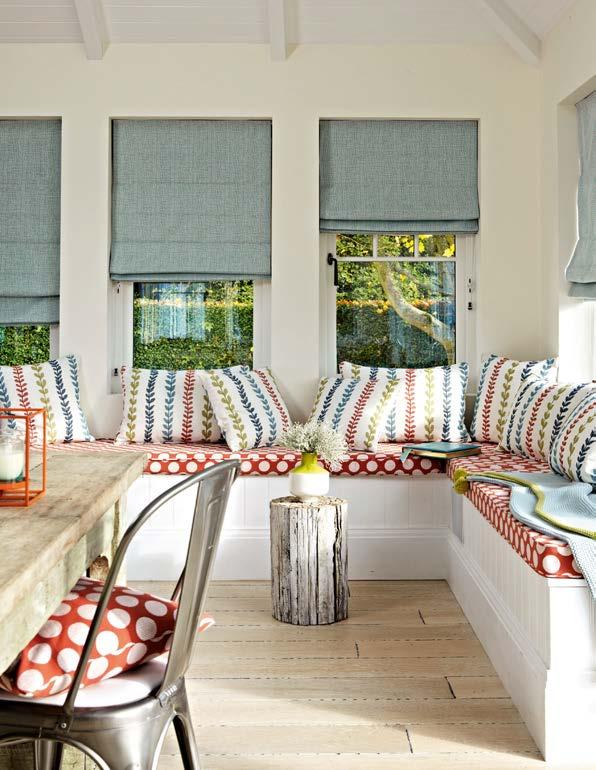
CONSERVATORY A conservatory should be predominantly glazed with over 75 per cent of the roof glazed, and a delicate frame – whether timber, metal or UPVC.
ORANGERY An orangery is a more substantial structure than a conservatory having pilasters, an inset roof and less glazing.
GREENHOUSE Designed for growing plants, these structures are single glazed. They can be freestanding in a desired spot in the garden – ideally near a vegetable patch or kitchen garden, but can be abutted to the house and have sliding doors adjoining the home for easy access.
GARDEN ROOMS A separate structure built in the garden – this could house a sitting room for teenagers, provide a home office, a gym or a place for pastimes, from art to music.
As with any external addition or garden structure, ensure if planning permission is needed. Most conservatories, provided they fall under certain conditions, will not require permission, but orangeries and other extensions may. Check with the local planning authority on gov.uk
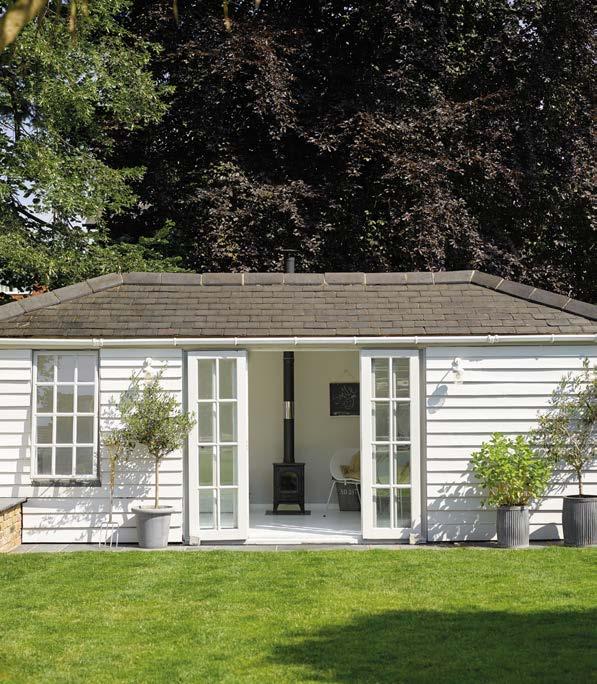
Style Notes
• Curtains can be used for winter warmth and privacy • Specialist blind treatments create shade when needed • Hard flooring is most practical but add rugs in natural materials for softness • Glass lampshades will make lights twinkle and gleam
ABOVE A separate garden room can pro ide a space for an additional space for ork, rela ing, or entertaining Painted in Pure Brilliant White, from £17 for 750ml 10-Year Exterior Satin, Sandtex

ABOVE dd a contemporary feel ith glass and rass pendants Pendant lights, from £72, Pooky RIGHT oman linds pro ide ad usta le shade and pri acy in a sunny, gla ed room Roman Blinds, from £72.55 each, English Blinds his greenhouse y artley otanic is easy to access from the house and pro ides a arm, sheltered spot for a morning cup of tea
LEFT Braid is used here to add a tailored finish to alls in different finishes in this scheme y interior design studio unter Co

YEAR-ROUND COMFORT
A garden room is naturally at its best when flooded with sunlight. But at the hottest times of the day or year, so much glazing can sometimes make them too warm, and simply being outside can be better. Alitex’s John Lawson notes that garden rooms, particularly greenhouses, are best enjoyed in spring and autumn “when the temperature is ideal for creating a warm space in which to escape the rest of the house for a coffee, to read the paper or even to exercise.”
Though greenhouses might be a little too cool in winter, a heated conservatory can be enjoyed throughout the year. The obvious attraction of a conservatory is the view outside, but in the cooler months or as evening falls, some window treatments might be desirable. Even in summer, it can be good to have a way of creating some shade. Blinds are the classic choice, and many companies offer specialist, flexible treatments for glazed roofs and walls. For a more gentle mood, voiles and sheers might soften harsh sunlight, whilst traditional curtains in heavier-weight textiles will provide comfort and warmth for a room used in winter – whether as an additional sitting or dining room, or a snug for watching television. Katharine Pooley notes that other additions can make the space useable year-round. “A log-burning stove can add a touch of comfort – perfect for warming up in the colder months, as well as giving the room a unique focal point,” she suggests. “Utilise throws and blankets as well for a subtle winter update to create an inviting snug.”
Lighting is also important for a room used in winter or in the evening. A beautiful chandelier can be the perfect choice, as it will catch the light and twinkle during the day – or opt for simple glass pendants. “Consider table lamps for a gentle glow,” Pooley suggests, “or if you choose a ceiling light, install a dimmer switch to create some more ambience.”
Emma Sims-Hilditch says that on some projects she has installed floor lighting leading from the garden room to the ourside to create an illusion of outdoorindoor living. “On one recent project,” she adds, “where the conservatory was to be used as an additional living room, we wanted to avoid a ‘glass box’ look. So we introduced textured rough boarding to the walls. Combining this with heavy weighted linen on the sofa, velvet cushions and a chunky woven wool rug, made the room a welcoming space in which to relax and enjoy the garden views beyond.”
On a practical note, garden room flooring needs to work year-round, connecting indoors and outdoors. Hard flooring – whether marble, wood or tiles – is the most practical option for footfall from outside and is easy to clean. A rug can be used to add interest and comfort underfoot, perhaps something made from natural fibres such as jute or seagrass to complement a natural or botanical theme.

ABOVE Emma Sims-Hilditch has used linen, wool, velvet and a crystal chandelier to make this a space to be enjoyed in cooler months, too. BELOW A modern garden room by Garden Retreats.



ABOVE Take cues from nature with a leaf pattern in pretty hues. Cushions in Lazza, £22 a metre, iLiv LEFT Outdoor furniture can be used indoors for a lightweight look. Corner sofa, £1,250, and all other furniture, Hampstead collection, Garden Trading BELOW Katharine Pooley has created yearround comfort ith lu urious oor-length curtains and a variety of lighting. BELOW LEFT Indulge in some comfort with a cosy armchair in a i rant oral fa ric Dakota armchair in Szekely Folk, £1,500, Mind The Gap
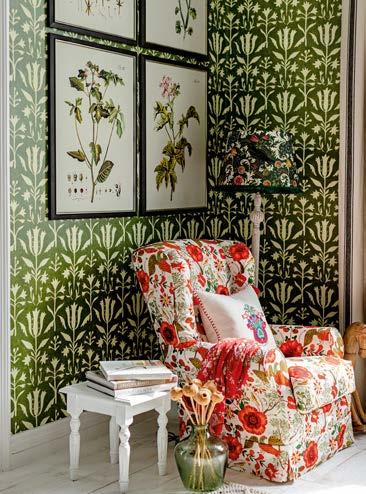
Style Notes
• Woven furniture is a natural natural choice for garden rooms • Consider armchairs or sofas if a garden room is to be used throughout the year • Indoor-outdoor fabric offers versatility and practicality, being water-resistant and less liable to fade in direct sunlight
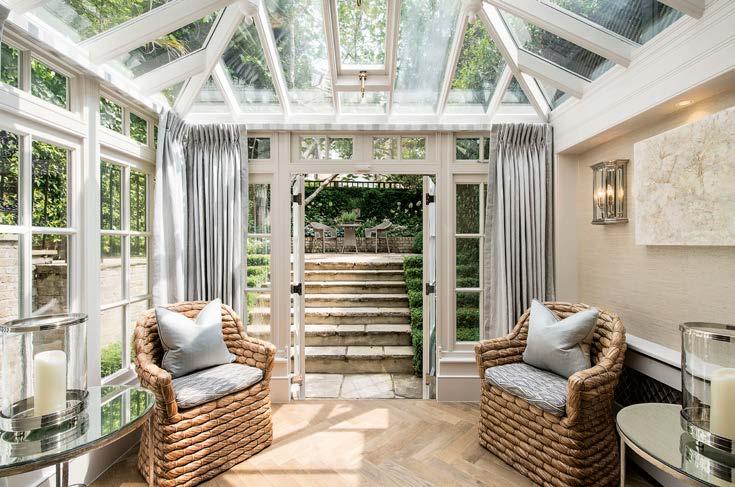
FURNITURE
A natural choice would be furniture that can be used indoors and out, perhaps to take onto a patio when the weather is fine and extra seating is needed.
Woven furniture such as rattan is a popular choice in this case. Aesthetically it works well with a verdant backdrop and, being light, can easily be taken outdoors, where it will not jar visually with any other outdoor furniture. Lightweight metal furniture offers similar advantages, particularly for dining tables.
“Furniture choices such as wicker and rattan will work well and give the space its own identity, drawing up an earthy theme to differentiate from other living spaces,” says Pooley. “Use wooden accents and foliage to accentuate this look, or consider more modern styles if you’re after a more contemporary feel.”
Removable seat-pads and cushions, perhaps covered in attractive and practical indoor-outdoor fabrics, are also an option. These types of fabrics are designed to be stain, mildew and water-resistant, and have better light-fastness than indoor fabrics, therefore less likely to fade in direct sunlight – an obvious boon in extensively glazed rooms. Traditional conservatory or garden furniture is not the only option for a garden room; conventional indoor furniture can work equally well, particularly in heated rooms used yearround. Sofas and armchairs are a must if the room is to be used, not just for an occasional cup of tea, but for significant periods of time. To lighten the look, add side tables or a bench in rattan or consider a statement wicker rocking chair. For those utilising the space as a sunroom, a sun lounger might also be a nice touch, offering the option for some serious relaxation. n




Order your free fabric samples at thefootstoolworkshop.co.uk

01443 831 981
Beautiful. Practical. Customisable.










